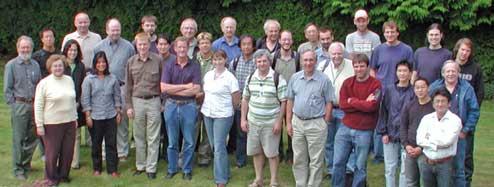
The properties of neutrinos has become one of the hottest topics in particle physics, following the discovery in 2001 by the Sudbury Neutrino Observatory that neutrinos have a tiny mass and can therefore “oscillate” between the electron, muon and tau types. The T2K (Tokai-to-Kamioka) experiment will further explore the oscillation properties of neutrinos by using a high energy particle accelerator now under construction at Tokai, on the east coast of Japan, to produce an intense, nearly monoenergetic beam of man-made neutrinos. These neutrinos will be aimed at the Super-Kamiokande neutrino detector, 295 km away near the west coast of Japan. In particular, T2K will try to observe the metamorphosis of muon type neutrinos into electron type neutrinos, a mode of oscillation which has never been observed before. A future upgrade will explore the question of whether anti-neutrinos behave differently from neutrinos; if so, this could provide the mechanism to explain why the universe has much more matter than anti-matter.
The T2K experiment is an international collaboration of 300 physicists from 12 countries. Canada has a strong contingent of about 50 researchers working on this project, from TRIUMF and the Universities of Victoria, British Columbia, Alberta, Regina, Toronto, and York. Canada is responsible for building several key components of the experiment. The Optical Transition Radiation Detector will precisely monitor the position of the proton beam on the target. The tracker section of the “Near Detector” will measure the properties of the neutrinos before they make the 295 km flight to Super-Kamiokande. TRIUMF is also contributing to the design of the proton beam line, as well as providing remote handling of the highly radioactive targets which produce the neutrinos.
The Canadian T2K collaboration annual meeting, which took place at TRIUMF from August 8-10, 2007, was attended by about 45 Canadian researchers from across the country. Progress reports on the development, construction and simulation of the various detector components were presented. Good progress is being made on all detector components. The Optical Transition Radiation Detector is ready to move into the construction phase by the Toronto/York/TRIUMF team. A full scale prototype of the 1 m x 2.4 m x 2.4 m Time Projection Chamber is under construction by the Victoria/UBC/Regina/TRIUMF team. Production modules of the fine grained scintillation detector have been constructed by the UBC/Victoria/Alberta/TRIUMF team.
The last day of the meeting was filled with excellent presentations by the undergraduate and graduate students working on various aspects of this experiment. The detectors are on schedule for commissioning in Tokai, Japan, in 2009.
